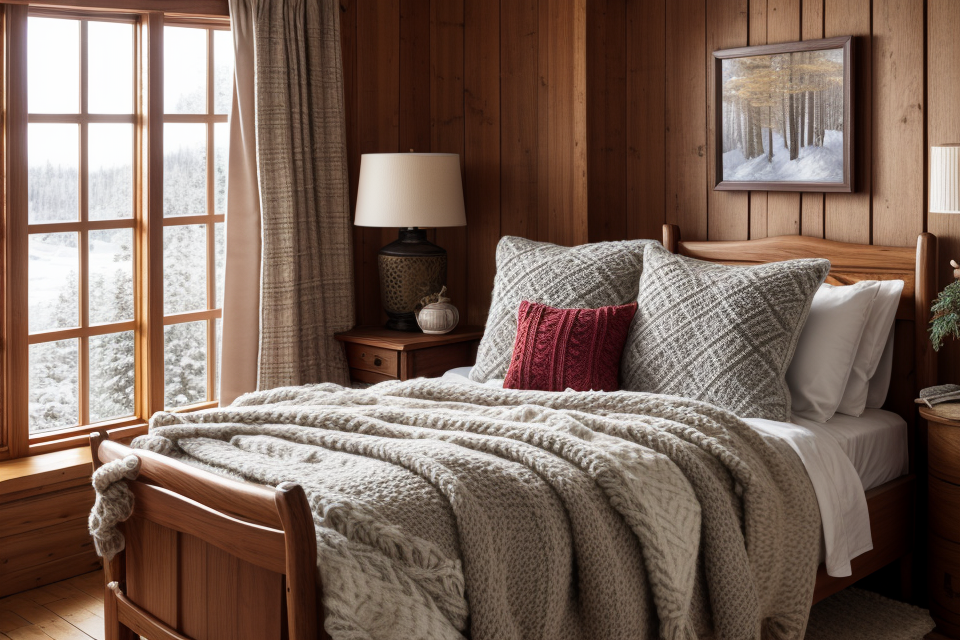Sweaters are a wardrobe staple for many people, providing warmth and comfort during the colder months. But how long do sweaters last? The answer to this question depends on a variety of factors, including the type of sweater, the materials it’s made from, and how well it’s cared for. In this comprehensive guide, we’ll explore the durability of sweaters and what you can expect from yours. Whether you’re a sweater fanatic or just looking to get the most out of your investment, read on to find out how long you can expect your sweaters to last.
The lifespan of a sweater depends on various factors such as the quality of materials used, care and maintenance, and frequency of wear. On average, a well-made sweater can last anywhere from 3 to 10 years or even longer. Factors that can affect the durability of a sweater include the type of yarn used, the weight of the sweater, and the type of construction. For example, sweaters made with high-quality materials like merino wool or cashmere may last longer than those made with cheaper materials. Additionally, sweaters that are washed and dried properly can last longer than those that are not. Overall, with proper care and maintenance, a sweater can last for many years and be a staple piece in your wardrobe.
Factors Affecting Sweater Durability
Material and Quality
Natural vs Synthetic Materials
The choice between natural and synthetic materials plays a crucial role in determining the durability of a sweater. Natural materials, such as wool and cotton, are generally more durable and long-lasting than synthetic materials like polyester and acrylic. This is because natural fibers are better at retaining their shape and structure over time, even after multiple washes and wear. In contrast, synthetic materials tend to lose their shape and form more easily, resulting in a shorter lifespan for the sweater.
Fiber Types and Durability
Different types of fibers also impact the durability of a sweater. For instance, wool is a popular choice for sweaters due to its warmth and durability. It is also a natural fiber that can be cared for properly to increase its lifespan. However, delicate fibers like silk and lace may not hold up well to frequent wear and washing, making them less durable than other materials.
Quality of Craftsmanship
The quality of craftsmanship also plays a significant role in determining the durability of a sweater. Sweaters that are made with care and attention to detail are more likely to last longer than those that are poorly made. Factors such as stitching, knitting, and construction all contribute to the overall quality of the sweater. Additionally, investing in higher-quality materials can also contribute to the longevity of the sweater. By taking these factors into consideration, consumers can make informed decisions about the durability and lifespan of their sweaters.
Care and Maintenance
When it comes to the longevity of sweaters, proper care and maintenance play a crucial role. Here are some factors that can impact the durability of your sweaters:
- Proper Washing and Drying Techniques: One of the most important factors in determining the lifespan of a sweater is how it is cleaned. It is recommended to wash sweaters by hand in cold water, as hot water can cause shrinkage and damage to the fibers. Additionally, it is important to use a gentle detergent and avoid using bleach or fabric softener, as these can weaken the fabric. When it comes to drying, it is best to air dry sweaters, as tumble drying can cause shrinkage and damage to the fibers.
- Storage and Handling: The way you store and handle your sweaters can also impact their durability. It is important to fold sweaters properly and avoid stacking them on top of each other, as this can cause creasing and damage to the fibers. Additionally, it is important to store sweaters in a cool, dry place, away from direct sunlight, as exposure to light and heat can cause fading and discoloration.
- Professional Cleaning: If you want to extend the lifespan of your sweaters, it may be worth considering professional cleaning. While washing and drying sweaters at home is generally safe, it can still cause wear and tear over time. A professional cleaner can use specialized techniques and equipment to clean your sweaters without causing damage. Additionally, they can repair any small holes or tears that may have developed over time.
By following these care and maintenance tips, you can help extend the lifespan of your sweaters and ensure they remain in good condition for as long as possible.
Wear and Tear
Common Signs of Wear and Tear
- Fading or discoloration
- Holes or tears
- Pilling or lint balls
- Fraying or unraveling edges
- Logo or label peeling off
Factors Contributing to Wear and Tear
- Frequency of wear
- Type of fabric
- Quality of materials and construction
- Type of care and cleaning
- Exposure to sunlight, water, and heat
Preventing Premature Wear and Tear
- Rotating sweater selection to reduce wear in the same areas
- Proper storage to avoid creasing or wrinkling
- Avoiding exposure to harsh chemicals, heat, and water
- Regularly checking for any signs of wear and tear
- Seeking professional repair or replacement when necessary
Longevity of Different Types of Sweaters
Acrylic Sweaters
Durability and Longevity
Acrylic sweaters are known for their affordability and versatility, making them a popular choice among consumers. They are made from a synthetic fiber that is derived from polymers, which gives them a soft and warm texture. While acrylic sweaters are not as durable as sweaters made from natural fibers like wool, they can still last for a relatively long time if properly cared for.
The lifespan of an acrylic sweater depends on several factors, including the quality of the material, the frequency of wear, and the care and maintenance practices. On average, an acrylic sweater can last for about 3-5 years if it is worn regularly. However, this can vary depending on the specific conditions and how well the sweater is taken care of.
Pros and Cons
One of the main advantages of acrylic sweaters is their affordability. They are typically much cheaper than sweaters made from natural fibers, making them an attractive option for those on a budget. Additionally, acrylic sweaters are easy to care for and can be machine washed and dried without any special treatment.
However, there are also some downsides to acrylic sweaters. One of the main drawbacks is their lack of durability. While they can last for several years if properly cared for, they are not as long-lasting as sweaters made from natural fibers like wool. Additionally, acrylic sweaters can pill easily, which can make them look worn and discolored over time.
Care and Maintenance
Proper care and maintenance can help extend the lifespan of an acrylic sweater. It is important to follow the care instructions on the label, which may include washing and drying instructions, as well as any specific care tips. Generally, acrylic sweaters can be machine washed and dried on a low heat setting to prevent shrinking or damage. It is also important to avoid using harsh detergents or fabric softeners, as these can weaken the fibers and cause damage over time.
Additionally, it is important to inspect the sweater regularly for any signs of wear or damage, such as holes, fraying, or discoloration. If any issues are found, it is important to address them promptly to prevent further damage.
Overall, while acrylic sweaters may not be as durable as sweaters made from natural fibers, they can still last for several years if properly cared for. With proper care and maintenance, they can provide a warm and comfortable layer of clothing for years to come.
Wool Sweaters
Wool sweaters are a popular choice for their warmth, softness, and durability. They are made from the fleece of sheep or other animals and can last for many years if cared for properly. Here are some factors that affect the longevity of wool sweaters:
- Durability and Longevity: Wool sweaters are known for their long-lasting quality. They are naturally resistant to moth larvae, which can damage other types of clothing. Wool also has a natural ability to insulate, which means it can keep you warm in cold weather and cool in hot weather. With proper care, a wool sweater can last for many years.
- Pros and Cons: One of the main advantages of wool sweaters is their durability. They can withstand a lot of wear and tear and can be passed down from generation to generation. Wool is also a natural material that is renewable and biodegradable. However, wool sweaters can be expensive and may require special care to maintain their shape and quality.
- Care and Maintenance: To keep your wool sweater in good condition, it is important to wash it properly. Wool sweaters should be washed in cold water and laid flat to dry. Avoid using fabric softener or bleach, as these can damage the wool fibers. It is also a good idea to have your wool sweater professionally cleaned every few years to remove any dirt or stains that may have accumulated. With proper care, your wool sweater can last for many years and remain a wardrobe staple.
Cotton Sweaters
Cotton sweaters are known for their durability and long-lasting quality. They are made from natural fibers that can withstand regular wear and tear. With proper care and maintenance, cotton sweaters can last for several years. The lifespan of a cotton sweater depends on various factors such as the quality of the fabric, the frequency of wear, and the care it receives.
One of the main advantages of cotton sweaters is their breathability. Cotton is a natural fabric that allows air to circulate, making it an excellent choice for people who live in hot climates or those who tend to sweat easily. Cotton sweaters are also comfortable to wear, soft to the touch, and come in a variety of styles and colors.
However, cotton sweaters have some disadvantages as well. They tend to shrink when washed, and the amount of shrinkage depends on the type of cotton used and the washing instructions. Cotton sweaters may also be more prone to pilling than other types of sweaters. Pilling is the formation of small balls of fibers on the surface of the fabric, which can be unsightly and difficult to remove.
To ensure that your cotton sweater lasts as long as possible, it is essential to take proper care of it. Here are some tips for caring for your cotton sweater:
- Wash your cotton sweater in cold water. Hot water can cause the cotton fibers to shrink and lose their shape.
- Use a mild detergent that is gentle on cotton fabrics. Avoid using bleach or fabric softener, as these can damage the fabric.
- Do not use fabric softener, as it can cause the cotton fibers to weaken and break down over time.
- Air-dry your cotton sweater instead of using a dryer. Drying in the sunlight is also an excellent option. This will help prevent shrinkage and keep your sweater looking newer for longer.
- Avoid ironing your cotton sweater, as it can cause permanent damage to the fabric. If you must iron your sweater, use a low heat setting and a pressing cloth to protect the fabric.
By following these care and maintenance tips, you can ensure that your cotton sweater lasts for years to come.
Blend Sweaters
Blend sweaters are a popular choice for their versatility and warmth. They are made from a combination of different materials, such as cotton, wool, and synthetic fibers. The durability and longevity of blend sweaters depend on the quality of the materials used and how they are cared for.
Durability and Longevity
Blend sweaters are generally considered to be quite durable and long-lasting. The combination of materials used in their construction provides a balance of warmth, breathability, and moisture-wicking properties. Additionally, blend sweaters are often made with high-quality materials that can withstand regular wear and tear.
However, the longevity of a blend sweater can vary depending on factors such as the type of materials used, the quality of the construction, and how the sweater is cared for. With proper care and maintenance, a blend sweater can last for several years.
Pros and Cons
One of the main advantages of blend sweaters is their versatility. They can be worn in a variety of settings, from casual outings to formal events, and their combination of materials provides a range of benefits. For example, the cotton in a blend sweater can provide a soft and comfortable feel, while the wool can provide warmth and insulation.
However, the combination of materials in a blend sweater can also be a disadvantage. Different materials may shrink or stretch at different rates, which can lead to a sweater that is ill-fitting over time. Additionally, blend sweaters may require more careful care and maintenance than sweaters made from a single material.
To ensure the longevity of a blend sweater, it is important to care for it properly. This includes washing it regularly (but not too frequently), using a gentle detergent, and air-drying it rather than using a dryer. Additionally, it is important to inspect the sweater regularly for any signs of wear or damage, and to have it repaired or replaced as needed.
By following these care and maintenance tips, you can help ensure that your blend sweater lasts for many years to come.
Factors Affecting Overall Sweater Longevity
Fit and Sizing
Proper Fit and Sizing
Ensuring that your sweater fits you well is crucial to its longevity. A sweater that is too tight or too loose can lead to wear and tear, while a proper fit will allow the fabric to move with your body, reducing the strain on the garment. Here are some factors that affect fit and sizing:
Body shape and size
Your body shape and size play a significant role in determining the right fit for a sweater. If you have a more athletic build, you may need a sweater that is cut a bit looser, while someone with a slimmer build may prefer a more fitted look.
Material and construction
The material and construction of a sweater can also affect its fit and sizing. For example, a sweater made from a heavier yarn may require a larger size to accommodate the extra material, while a sweater made from a lighter yarn may be more form-fitting.
Style and design
The style and design of a sweater can also impact its fit and sizing. For instance, a sweater with a lot of intricate details or embellishments may require a smaller size to prevent the details from bunching up or looking awkward.
Tips for Prolonging Sweater Longevity
To prolong the longevity of your sweater, here are some tips to keep in mind:
Wash and care for your sweater properly
Follow the care instructions on the label of your sweater to ensure that it is cleaned and cared for properly. This can help prevent damage to the fabric and reduce the risk of shrinkage or fading.
Store your sweater properly
When not in use, store your sweater in a cool, dry place, away from direct sunlight. This can help prevent shrinkage and maintain the shape and form of the garment.
Spot clean when necessary
If you notice any stains or spills on your sweater, try to spot clean them as soon as possible. This can help prevent the stain from spreading and prolong the life of the garment.
Sweater Usage and Frequency
Factors Affecting Usage and Frequency
The frequency and intensity of usage play a crucial role in determining the longevity of a sweater.
- Washing: The number of times a sweater is washed affects its lifespan. Frequent washing can cause wear and tear, especially if the garment is not cared for properly.
- Storage: The way a sweater is stored can also impact its durability. Improper storage, such as folding or stacking sweaters, can cause creasing and damage to the fabric.
- Physical Activity: The level of physical activity a sweater is subjected to can affect its lifespan. Sweaters that are used for high-impact activities, such as hiking or skiing, may wear out faster than those used for more gentle activities.
Proper Care and Maintenance
Proper care and maintenance can help extend the life of a sweater.
- Washing: Sweaters should be washed in cold water to prevent shrinkage and damage to the fibers. It is also recommended to wash sweaters inside out to protect the design and avoid damage to the surface of the fabric.
- Drying: Sweaters should be dried on a flat surface, away from direct heat, to prevent shrinkage and damage to the fibers.
- Folding: Sweaters should be folded gently and stored in a cool, dry place to prevent creasing and damage to the fabric.
Tips for Prolonging Sweater Longevity
There are several tips that can help prolong the life of a sweater.
- Air Drying: When possible, it is best to air dry sweaters rather than using a dryer, as the heat from a dryer can cause damage to the fibers.
- Spot Cleaning: If a sweater becomes dirty, it is best to spot clean the area rather than washing the entire garment. This helps to prevent shrinkage and damage to the fibers.
- Regular Checks: It is important to regularly check sweaters for signs of wear and tear, such as loose threads or fraying. Addressing these issues early can help prevent further damage.
Environmental Factors
Environmental Conditions
Environmental conditions play a significant role in determining the lifespan of a sweater. Factors such as temperature, humidity, and exposure to light can all affect the fabric’s durability and colorfastness. For instance, excessive heat and sunlight can cause the colors to fade and the fabric to weaken, shortening the sweater’s lifespan. On the other hand, extreme cold temperatures can cause the fibers to become brittle and weak, leading to wear and tear.
Proper Storage and Handling
Proper storage and handling are also crucial in determining the longevity of a sweater. Sweaters should be stored in a cool, dry place, away from direct sunlight, to prevent color fading and fabric deterioration. Additionally, sweaters should be handled with care to prevent snags and tears. It is recommended to avoid stacking sweaters on top of each other, as this can cause damage to the fibers.
To prolong the lifespan of a sweater, there are several tips that can be followed. One of the most important is to follow the care instructions on the label. This includes washing and drying the sweater correctly, as improper care can cause damage to the fabric. Additionally, it is recommended to periodically inspect the sweater for any signs of wear and tear, and to repair any damage as soon as possible to prevent further deterioration. Finally, it is important to store the sweater properly when not in use to prevent stretching and other forms of damage.
Extending the Life of Your Sweaters
Tips for Maximizing Sweater Longevity
- Regular Care and Maintenance
Proper care and maintenance are crucial in extending the life of your sweaters. Here are some tips:
- Washing and Drying
Always follow the care label instructions when washing your sweaters. Use a gentle detergent and cold water to prevent shrinkage and damage to the fibers. Avoid using chlorine bleach on sweaters made of protein-based fibers such as silk, wool, and cashmere, as it can weaken the fibers and cause yellowing. When drying, avoid using heat as it can cause shrinkage and damage to the sweater. Instead, air-dry your sweaters flat or hang them on a coat hanger.
- Storing Sweaters
When storing your sweaters, always fold them neatly and place them in a cool, dry place with good ventilation. Avoid storing your sweaters in plastic bags or boxes, as this can cause them to trap moisture and develop mildew. You can also use storage containers with compartments to keep your sweaters organized and prevent them from getting wrinkled.
- Repair and Rejuvenation
If your sweater has tears or holes, it’s best to repair them as soon as possible to prevent further damage. For small tears, you can use fabric glue or sew them up using a needle and thread. For larger holes, you may need to use a sewing machine to repair them. You can also rejuvenate your sweaters by removing stains or restoring their original shape and color using specialized products.
By following these tips, you can help extend the life of your sweaters and keep them looking and feeling their best for as long as possible.
Frequently Asked Questions
Common Questions About Sweater Durability and Longevity
- How often should I wash my sweaters?
- Can I machine wash my sweaters?
- How do I spot clean a sweater?
- What is the best way to store my sweaters?
- Can I repair my sweater if it gets a hole or tear?
Additional Tips and Advice
- Choose sweaters made from high-quality materials for longer-lasting garments.
- Avoid exposing your sweaters to extreme temperatures, as this can cause damage.
- Take your sweaters to a professional dry cleaner for cleaning and repairs.
- Rotate your sweaters to prevent wear and tear on specific areas.
- Consider investing in a sweater with a lifetime guarantee for maximum durability.
FAQs
1. How long do sweaters typically last?
Sweaters can last anywhere from a few months to several years, depending on the quality of the material, the care they receive, and how often they are worn. On average, a well-made sweater can last for about 3-5 years.
2. What factors affect the lifespan of a sweater?
The lifespan of a sweater can be affected by several factors, including the type of fabric it is made from, the quality of the materials used, how often it is worn and washed, and how well it is cared for. Sweaters made from high-quality materials and constructed with durability in mind can last longer than those made from lower-quality materials.
3. How can I make my sweater last longer?
There are several ways to make your sweater last longer, including washing it less frequently, using a gentle detergent, air-drying it instead of using a dryer, and storing it properly when not in use. Additionally, regular inspection for any signs of wear and tear, such as holes or fraying, can help identify when it’s time to replace the sweater.
4. What are the signs that my sweater needs to be replaced?
There are several signs that your sweater may need to be replaced, including holes, fraying, discoloration, and significant shrinkage. If the sweater is no longer comfortable to wear or is no longer the right size, it may also be time to replace it.
5. How can I tell if a sweater is well-made and durable?
To determine if a sweater is well-made and durable, look for high-quality materials, such as wool or cashmere, and check for stitching and construction details that indicate it was made to last. Additionally, reading reviews and considering the brand reputation can also provide insight into the durability of a sweater.



